ROLE
User Research, Concept Design, Writing
TIME FRAME
Capstone Challenge | Spring 2023
TEAM MEMBERS
Nicholas Palomino, Kaylnn Porter, Lisa Skinbinskaya
Design Challenge
Problem
The standard gadget case is used to store small technology such as chargers, small headsets, and usb cables for traveling on the go, whether than be for a long or short distance trip during one’s travels. The problem with gadget cases is they are either thrown out after a trip or stuffed in the back of a closet never to see the light of day. When gadget cases are thrown out it contributes to the consumer waste that builds up everyday.
Insights
Conducting our research, we searched into reviews of gadget cases to understand user preferences and gripes with various types of cases. We have inspiration from other products, ranging from kitchenware to regular backpacks, and have found out owners use for them beyond for multipurpose use. Some repurposed theirs as craft kits, lunch packs, and a young girl uses her gadget case to store her toys. This got us thinking about how we could level up the functionality and versatility of the gadget case design.
Solution
A redesigned on-the-go gadget bag designed not only to store your tech gadgets and cords but also to offer multi uses for your trips. It serves as a versatile go bag that can be worn in different ways, such as a backpack or crossbody bag. The main components of this bag include: removable and adjustable organizers, allowing you to easily fit your technology and essential items when you're on vacation travels. Additionally, our on-the-go bag comes with a digital companion Wren, a digital Corgi chatbot designed to assist solo student travelers on their journey in a new city.
A digital companion Wren, a digital Corgi chatbot designed to assist solo student travelers on their journey.
The Gadget Case
We researched gadget cases in the market to insights from different variations of the product. Also, we researched gadget cases that had modular organizers conveniently designed for extra storage space, and woven straps for wires. Some gadget case designs were used to be carried on the go rather than be stored in larger travel bags like backpacks and luggage.
Customer Inquiries
We researched user reviews of different variations of gadget case designs. Two users express their concerns over gadget cases they purchased and received.
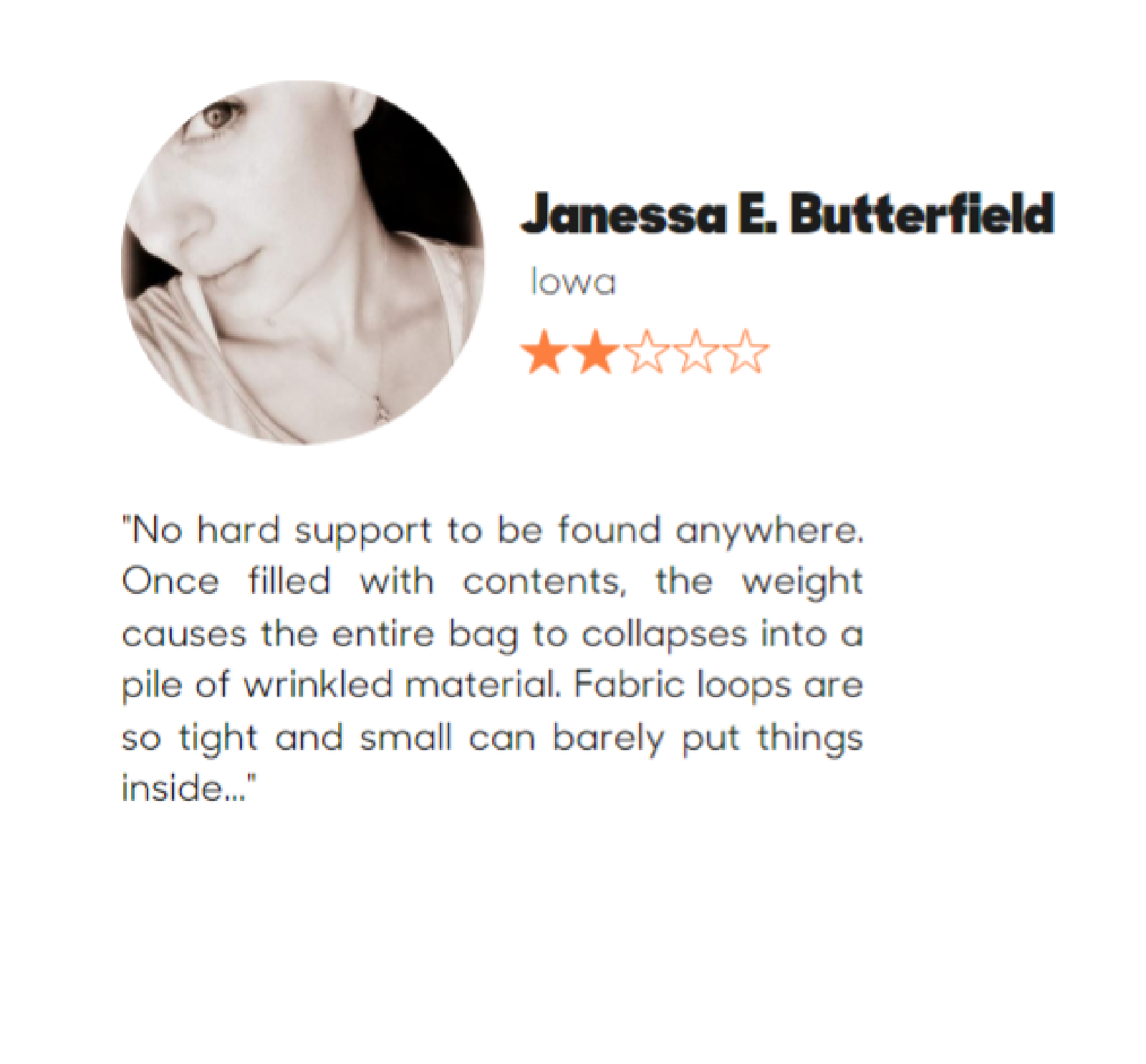

Janessa purchased and received a gadget case that had “no hard support” and found the bag to be “wrinkly”.
K. Fisher received a hard shell gadget case that “takes up a decent amount of room” in their backpack. It made us wonder what materials we could use to not only make the gadget case more sustainable but practical to meet the needs of users who use them.
Brand Identity
A collection of EF merchandise expertly designed by MaCher, along with a range of travel accessories specifically curated for student travelers. One example was Ciera's travel backpack, which was designed for the travel pack to separate into two parts.
Concept Sketches
Building upon our research, we conceptulized our first drafts with each of us having different takes on how the case can be transformed. We included modular organizers, elastic grids, and foldable storage in the gadget case to accommodate additional items. Our design inspiration drew heavily from backpacks, luggage, and even kitchen tools used to store knives and utensils.
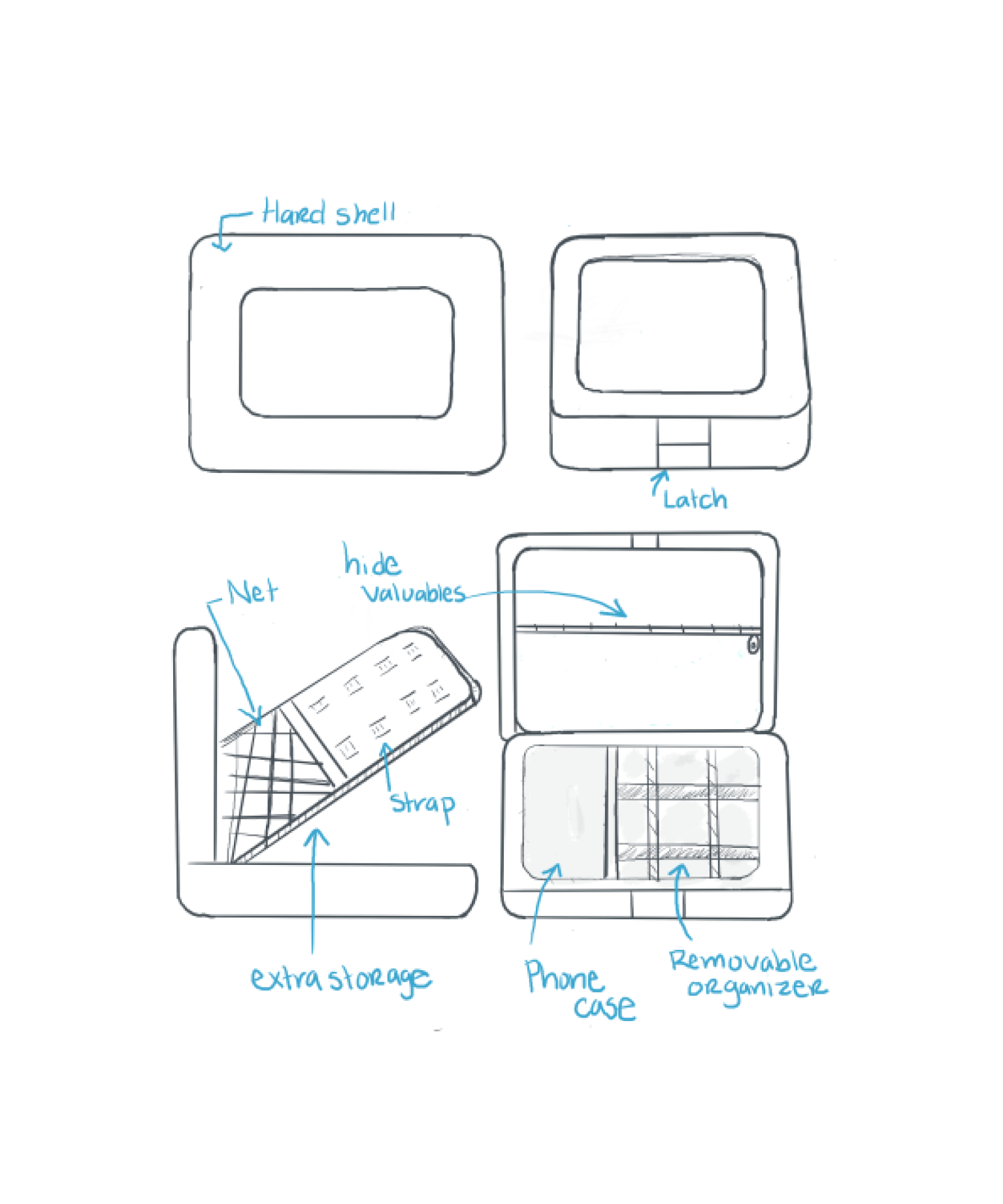
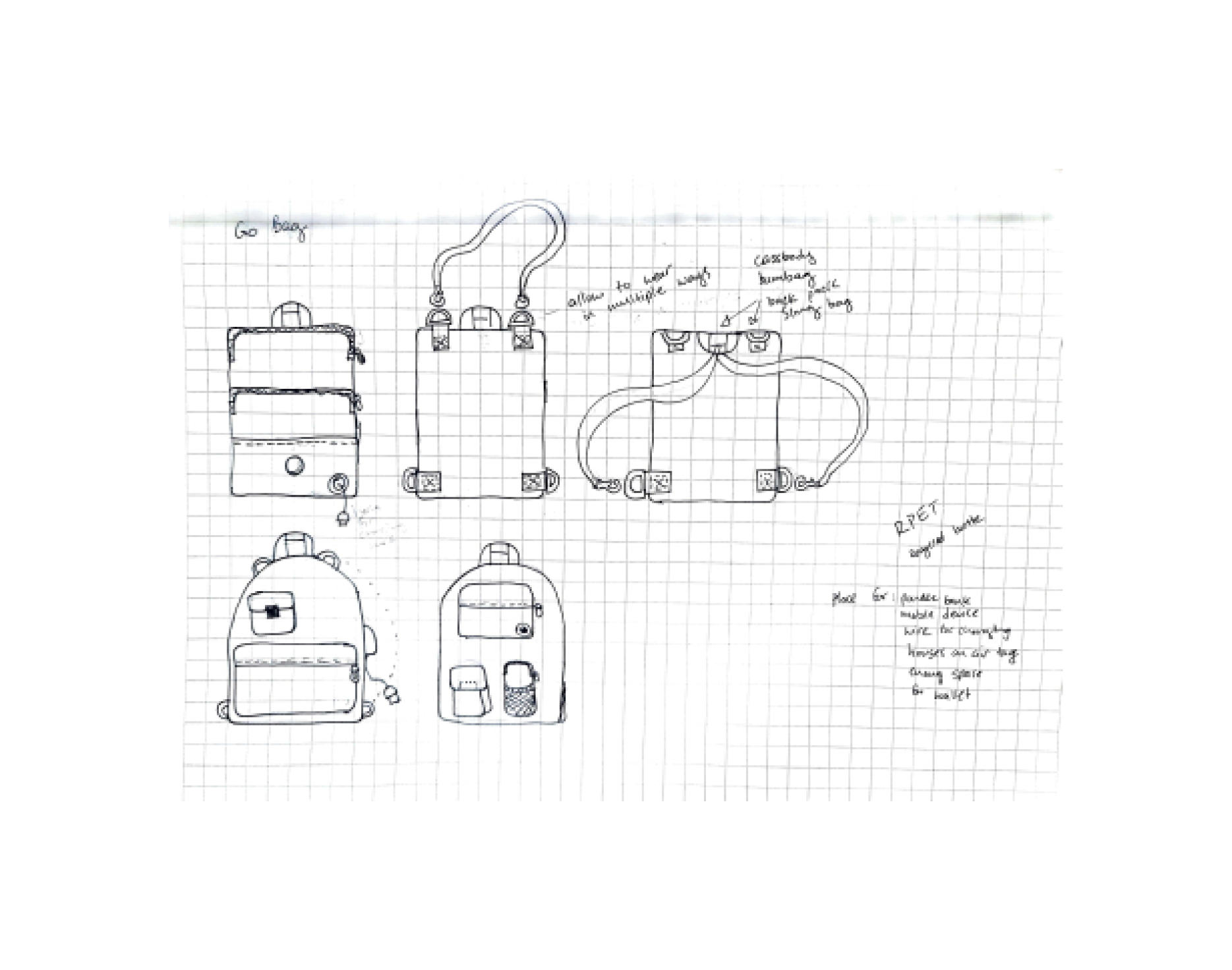
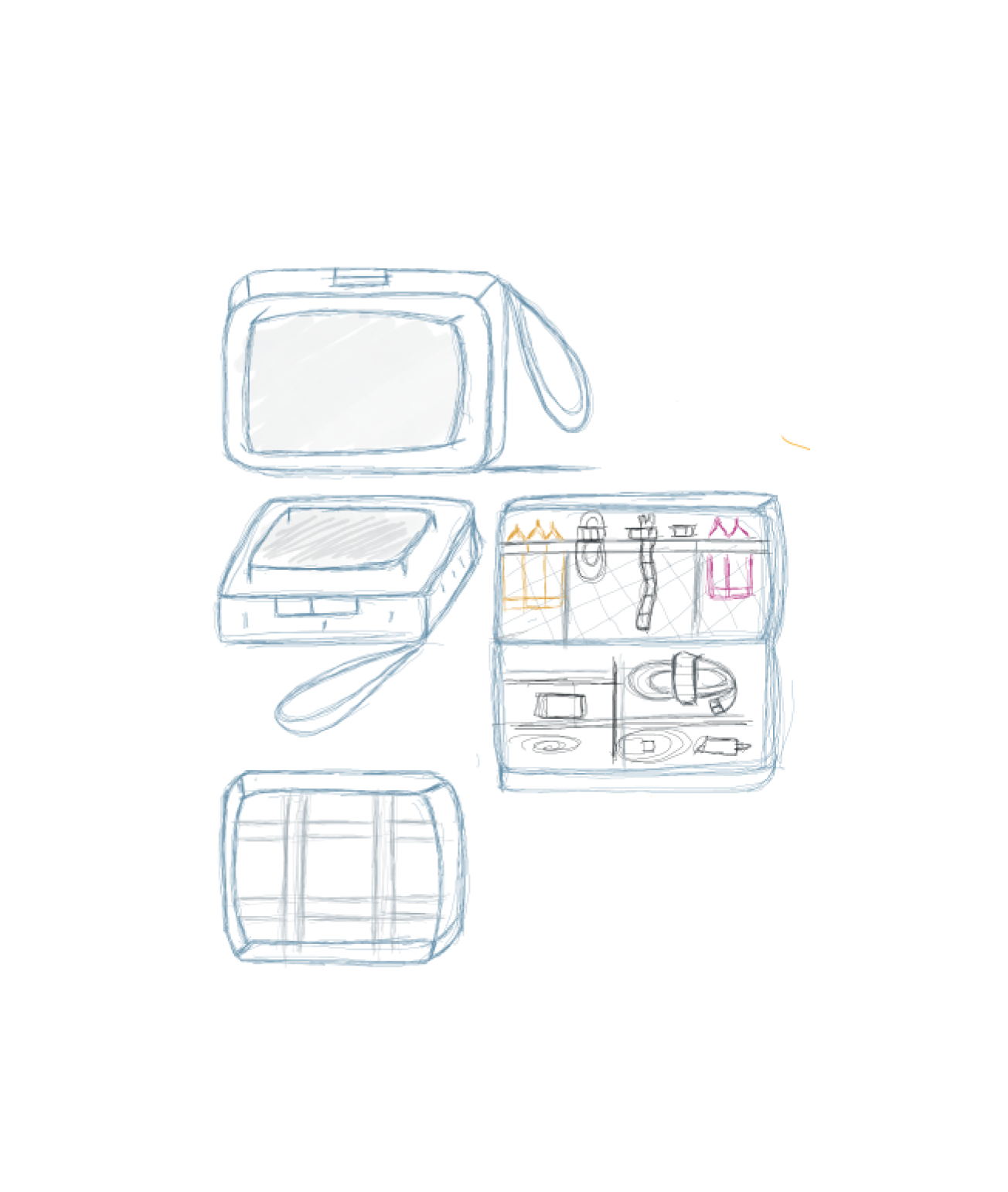
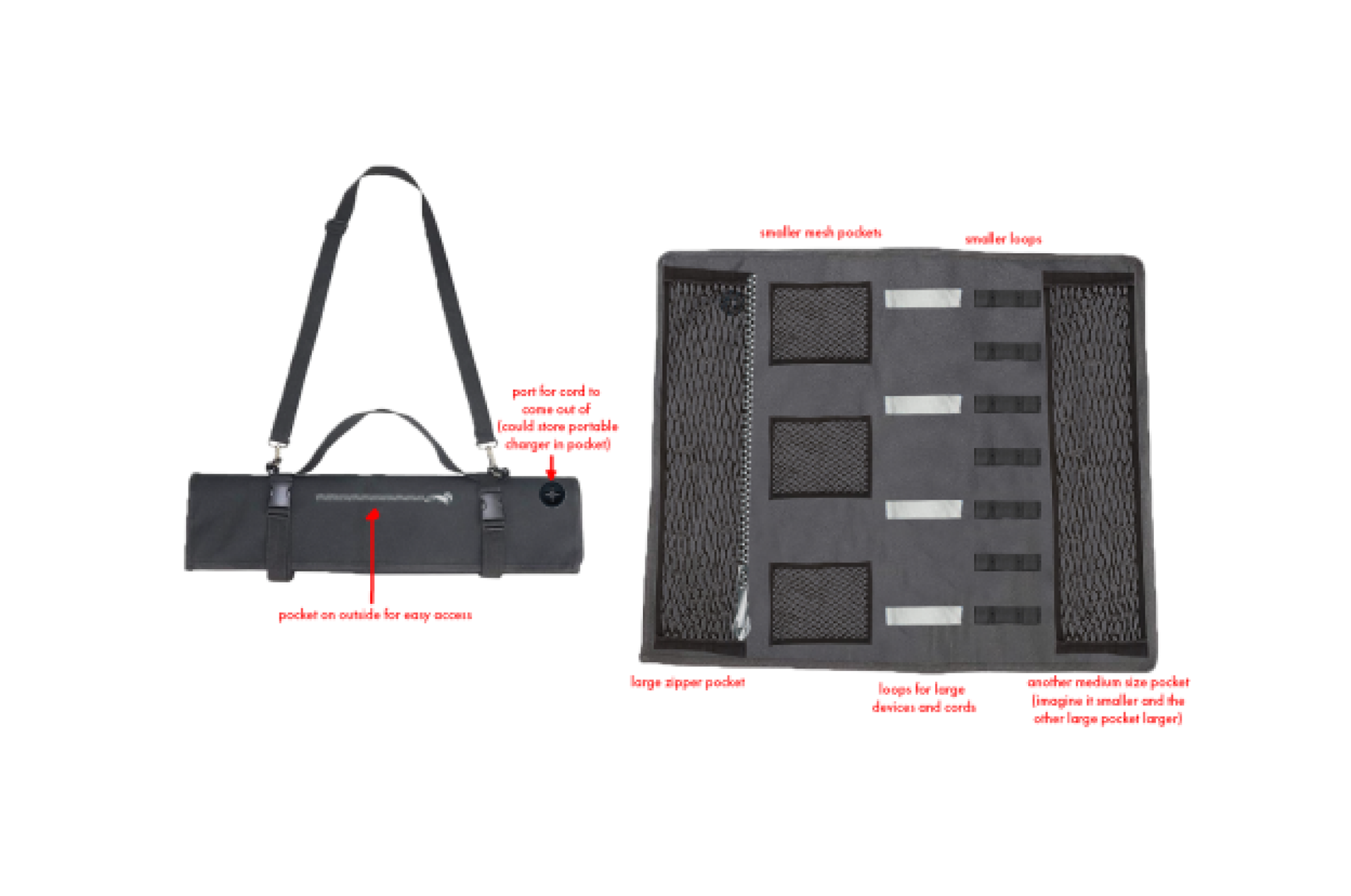
Digital Concept
Packpoint, which offered travel packing lists and planned itineraries to help users prepare for their trips. Our goal was to develop a digital companion to accompany our go bag, providing assistance throughout the travel journey. We aimed to build on a reasonable solution for users to continue using and reusing the gadget case even after their trip had ended.
Packpoint offered a great idea for engagement, we still sought ways to enhance the value and reusability of the physical product.
How can we effectively engage users throughout their entire travel experience with the gadget bag?
Contiki offers a range of travel packages aimed at student travelers to connect with other students in a new city so they aren’t alone.
How did we plan to use Contiki for our digital concept?
We considered sending a customized travel package to the travelers, which could include relevant information and resources. To enhance their exploration of a new city, we envisioned a QR code that would lead them to a dedicated webpage where they could participate in a thrilling scavenger hunt experience.
Design Process
We drew inspiration from Contiki developing our digital component to accompany our gadget case. We envisioned incorporating a chatbot experience that would provide personalized travel recommendations and tips to student travelers before embarking on their trips.
User Feedback
Based on our user tests, we decided to narrow down our concept to being a chatbot assistance. It's main purpose is to provide resources and a pre planned itinerary for traveling students that way they can use their go bag to receive helpful assistance during their trip.
Quote : "I’m not willing to go to a separate website in order to get access to the text messages. Since the travel company has the users contact information, can’t they send the user an introductory message where they can opt in or out to the service."
What better way to be engaged with the Chatbot than having a mascot?
Wren, a digital assistant is used to engage users to not only use the assistance but promote engagement with users post trip, by having customizable filters to be distributed and promote product and the bag on social media platforms.
Physical Concept
Based on our concept drawings we were able to settle on a concept that would make the go gadget bag possible to recreate with our physical model. For example, we incorporated concept features such as modular organizers to remove or add to place personal items and belongings, a grid system, and d-rings and straps so that students can customize the way they wear the gadget bag.
The gadget bag based on our initial concepts.
Physical models
For our physical models, we each explored different material and style options to create a prototype that would best represent our final design. We initially looked into sustainable materials suitable for both the outer and inner linings of the bag. After careful evaluation, we narrowed down our choices to three: technik leather, washable paper, and RPET.
Ultimately, we opted for RPET 600D as the main material for our gadget bag. This decision was driven by its sustainability, accessibility, and affordability, making it an ideal choice for our design.
Gadget bag (physical models)
Iterations
The feedback we received played a role in refining our physical model. One suggestion raised the question of whether the grid system was necessary and if it would occupy too much space. Additionally, the size of the bag was deemed to be on the smaller side. We had to consider the dimensions of the bag before creating the physical model. Our aim was to have the right balance, ensuring that the bag was not overly large and bulky, but the perfect size, refined to meet user expectations.
3D models
In general, we utilized 3D software like Fusion 360, Shapr, and CLO3D to create various versions of the gadget bag, exploring different materials, and refining its appearance. This allowed us to visualize the bag in detail and experiment with different textures and finishes to determine the desired look.
Additionally, we defined a suitable color palette for the bag, ensuring it aligned with MaCher's product branding. Throughout the process, we had the opportunity to iterate on the form of the 3D model, improving the realism of the bag.
Final Concepts
1. The physical component is the "On-The-Go Gadget Case," designed to store tech gadgets and cords while offering versatile functionality.
2. It features removable and adjustable organizers to accommodate various items and maximize storage efficiency.
3. The case is constructed using sustainable materials like RPET 600D, ensuring durability and reducing environmental impact.
"Wren", complements the physical gadget case as a personalized travel companion. Wren is a digital chatbot accessible via Wi-Fi and SMS messaging.
Upon purchasing the gadget case, users receive an activation leaflet in their travel package connecting them to Wren. This unlocks a range of features such as travel tips, city guides, and real-time assistance.
Wren also provides customizable filters for post-trip sharing on social media, promoting the MaCher brand. It enhances the travel experience by offering practical support and fostering a community of travelers.
Tools and Methods
1. Software: We will employ software tools such as programming languages and 3D modeling software (Fusion 360, Shapr, CLO3D), as well as chatbot development platforms to create and refine the digital components. We researched SMS plans and services that are able to send texts collectively or individually. Moving forward, we can research ways in which we could utilize AI programming and SMS to test sending and receiving, as well as to develop accurate information for our digital platform.
Software tools
2. Hardware: The physical gadget case requires suitable materials, such as RPET 600D, to ensure durability and sustainability. Hardware components like zippers, adjustable organizers, and straps will be needed to assemble the gadget case. Here we have our bill of materials, which lists all the parts of the gadget case and their potential costs based on our research.
3. Platforms: We will utilize various platforms, such as Wi-Fi networks, messaging platforms, and cloud-based hosting services, to facilitate connectivity and communication between our Wren chatbot and user devices. During the development phase of our project, one idea was to include an instructional manual within the package. This manual would provide the traveler with all the necessary information to access the digital concierge.
4. Procedures and Policies: The implementation of our proposal requires clear procedures for data privacy and user engagement. We want to ensure that user information is protected, and ethical considerations are upheld throughout the development and deployment phase.
Reflection
What worked
Redesigning MaCher's gadget case into a go gadget bag was challenging, but we combined our best ideas to enhance its functionality. For the digital component, we explored webpages, apps, and GPS integration. After thorough research, we opted for a cost-effective message-based chatbot and SMS integration. This experience taught us to balance cost, user convenience, and practicality.
What didn’t
When it came to the digital component, finding a solution that met the needs of the client and users proved challenging during the process. We gathered feedback from our users and mentors, which, although helpful, was also overwhelming when trying to reach a conclusion. However, we managed to rely on research and costing to address the bias towards choosing between a web or message platform for the digital companion. Ultimately, we feel confident that our message-based solution accompanying the gadget bag can be practically implemented moving forward.
What I would do differently
I would have prioritized gathering more research on cloud-based and SMS-based integration to increase our confidence in the feasibility of our solution. Moving forward, we can explore the process of sustainable production, packaging, obtaining approval from the company or authorizers, consumer delivery, and conducting comprehensive user testing for both the physical and digital aspects of the product.
